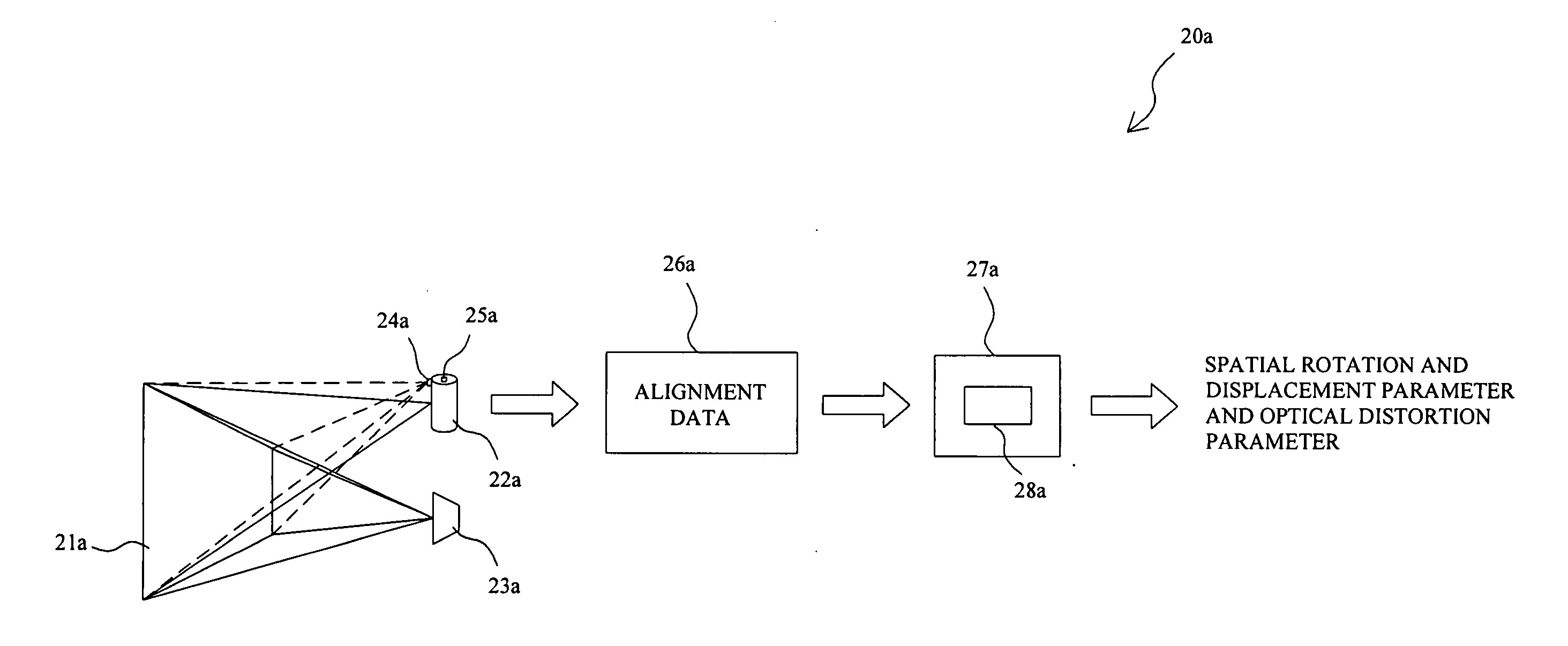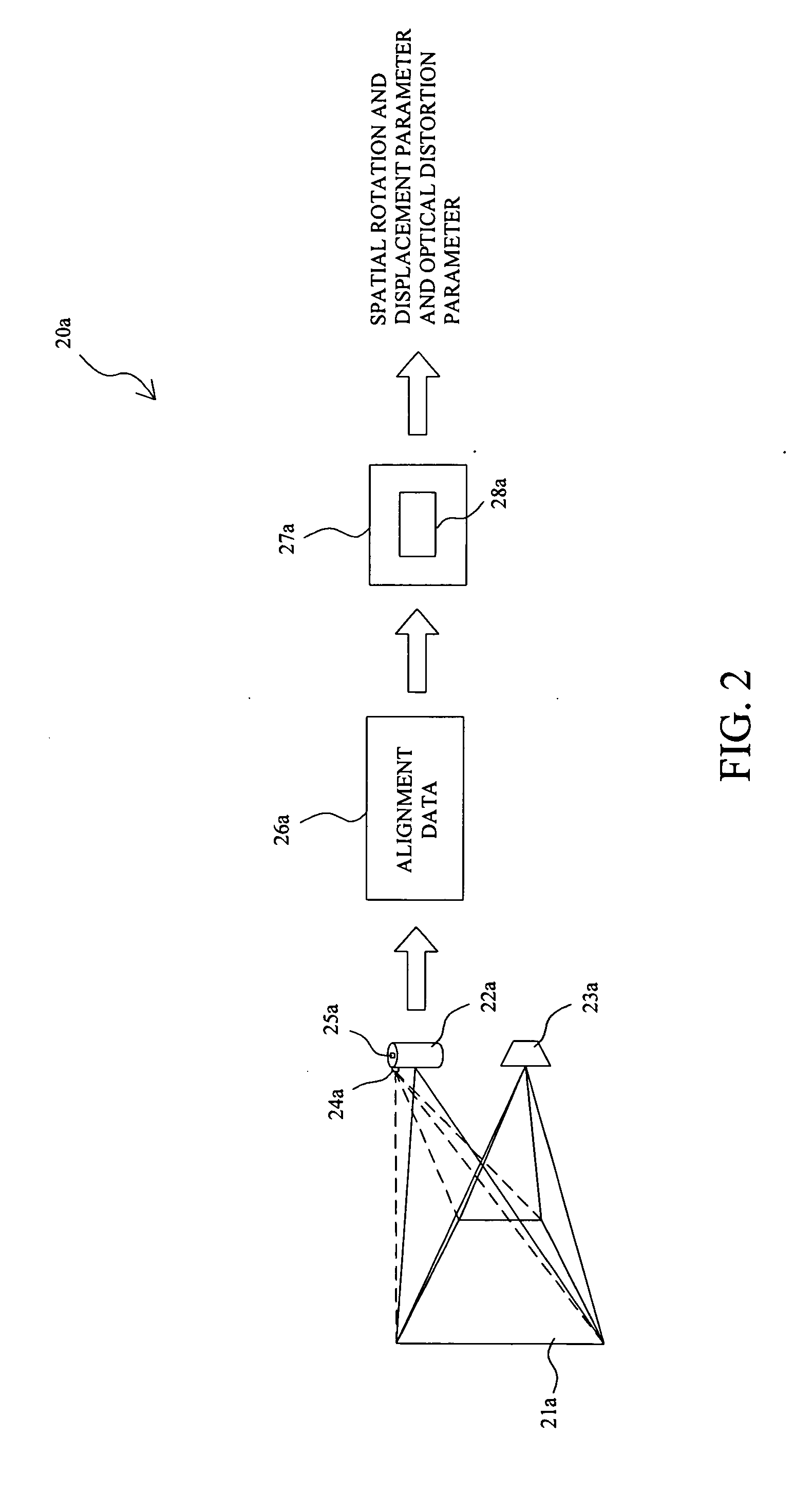Pointing input system and method using one or more array sensors
a technology of array sensors and input systems, applied in the direction of input/output for user-computer interaction, instruments, computing, etc., can solve the problems of inconvenient use of trackballs for writing on upright screens, touch panels are disadvantageous to alignment and portability for larger screens, and input systems using conventional sensors may often suffer alignment degradation
- Summary
- Abstract
- Description
- Claims
- Application Information
AI Technical Summary
Problems solved by technology
Method used
Image
Examples
first embodiment
of Pointing Input System
[0025]FIG. 5 shows a pointing input system 40 applied for an information system using single front projector 41 and single array sensor 42. In the pointing input system 40, after an alignment procedure 20a illustrated in FIG. 2, a pointer 46 could be used for direct inputs on a screen 43. The light spot 47 projected by the pointer 42 on the screen 43 is shot by the array sensor 42 to generate a first data including the image information of the light spot 47 sent to a computer system 44, where an identification system 49 running on the computer system 44 retrieves a second data including the position information of the light spot 47 from the first data based on the optical distortion parameter and spatial rotation and displacement parameter that are obtained by the alignment procedure 20a. The second data is provided for the projector 41 to display a correlated output on the screen 43. In FIG. 5, the correlated output is an image of the light spot 47, while in...
second embodiment
of Pointing Input System
[0026]FIG. 6 shows a pointing input system 50 applied for an information system using single front projector 51 and multiple array sensors 52. After an alignment procedure 20a illustrated in FIG. 2, the system 50 allows a pointer 46 to directly input on a screen 53. The array sensors 52 are arranged in different directions to shoot on the screen 53, and thus, if one of them is unable to shoot the light spot on the screen 53 properly, another is switched instead to shoot on the screen 53, so as to achieve the purpose of full viewing angle without any loss. Since several array sensors 52 are provided in the system 50, the screen 53 may have very large area for display. The other operations are referred to the first embodiment 40 illustrated in FIG. 5. The identification system is not shown in FIG. 6 for simplicity.
third embodiment
of Pointing Input System
[0027]FIG. 7 shows a pointing input system 60 applied for an information system using multiple front projectors 61, multiple array sensors 62, and multiple pointers 63. In this system 60, a screen 64 is defined to have several projection regions each one is responsible by a projector 61 to display thereon and by an array sensor 62 to shoot thereon, so as to improve the resolution. After an alignment procedure 20a illustrated in FIG. 2, the pointers 63 are allowed in this system60 for direct inputs on the screen 64. By using the pointers 63, it is achieved multiple inputs from several persons or opinion exchanges between several persons, without any additional equipments. Using the pointers 63 for direct inputs on the screen 63 may be referred to the first embodiment 40 illustrated in FIG. 5. The identification system is not shown in FIG. 7 for simplicity.
PUM
 Login to View More
Login to View More Abstract
Description
Claims
Application Information
 Login to View More
Login to View More - R&D
- Intellectual Property
- Life Sciences
- Materials
- Tech Scout
- Unparalleled Data Quality
- Higher Quality Content
- 60% Fewer Hallucinations
Browse by: Latest US Patents, China's latest patents, Technical Efficacy Thesaurus, Application Domain, Technology Topic, Popular Technical Reports.
© 2025 PatSnap. All rights reserved.Legal|Privacy policy|Modern Slavery Act Transparency Statement|Sitemap|About US| Contact US: help@patsnap.com



